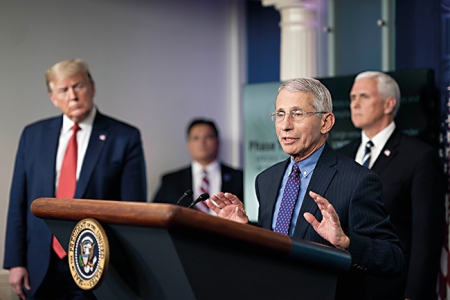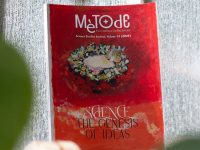
Official White House. Photo by Andrea Hanks
Dr. Anthony Fauci, Director of the United States’ National Institute of Allergy and Infectious Diseases, is the public face of science for many of us during the COVID-19 crisis, offering patient explanations in an exhausting run of press briefings and interviews. For the most part, his performance as a science communicator has been exemplary, except in one case where a seemingly innocuous turn of phrase trips him up.
«Doctor Anthony Fauci is the public face of science for many of us during the COVID-19 crisis in the USA»
Fauci is good at risk communication because he uses simple metaphors to convey the complexities of public health decisions. For example, to prepare people for the reopening of businesses, he draws a comparison from that very domain, cautioning that «it is not going to be a light switch that we say, OK, it is now June, July or whatever, click, the light switch goes back on». Using a metaphor from the world of commerce to help people understand that some parts of the country should go back to work before others, he says «it’s going to have to be something that is not one size fits all». To help sports fans understand the need for policies that constrain movement, he argues for «a full press on the mitigation» to control the virus. These are all unassuming analogies, well designed to persuade laypeople to accept the rationale behind scientists’ recommendations.
Early criticism of COVID-19 rhetoric cautions against the use of war metaphors that can shift us toward authoritarian and nationalistic sentiment, evoking xenophobia and racism. Worried about these entailments, scholars have mobilized #ReframeCovid to promote alternatives, such as the journey metaphor, where we imagine ourselves moving toward a destination rather than fighting an invisible enemy. Fauci seems to have intuited that rhetorically prudent approach. While not entirely avoiding the war metaphor, he more often see us as being on a journey, «starting to turn the corner (…) to get us to where we want to be». In conjunction with the ubiquitous command to “flatten the curve,” the imagery of movement along a path seems ideal for thinking about decisions at one point in time having consequences at another. It urges patience, since we know the discomfort of travel will end once the destination is reached. Like metaphors from the worlds of commerce and athletics, it is a subtle argument drawing from a familiar source domain to turn the unknown into something we can face.
However, in characterizing our response to a viral pandemic, the journey metaphor creates a puzzling disjunction. After all, it is our very movement that is being stopped to halt the spread of the coronavirus. Travel has been cancelled. Stuck at home, we no longer transport ourselves from one place to another. It is stasis that we are being asked to endure, not the hero’s journey. The incoherence of this metaphor to describe the current moment is made most clear when Fauci uses it to explain why social distancing guidelines had to be extended at the end of March. «It would not have been a good idea to pull back at a time when you really needed to be pressing your foot on the pedal as opposed to on the brakes (…) we felt that if we prematurely pulled back, we would only form an acceleration or a rebound of something, which would have put you behind where you were before.» I get what he is saying here, but it is jarring to think of the directive to continue staying at home as the acceleration of a vehicle, the imagined resumption of travel as a braking action, and the end of a 10-foot distance rule as a pulling back. The metaphor is logically and psychologically flawed. It is the one spot where Fauci stumbles in his otherwise successful run as public communicator of science during the coronavirus pandemic.





